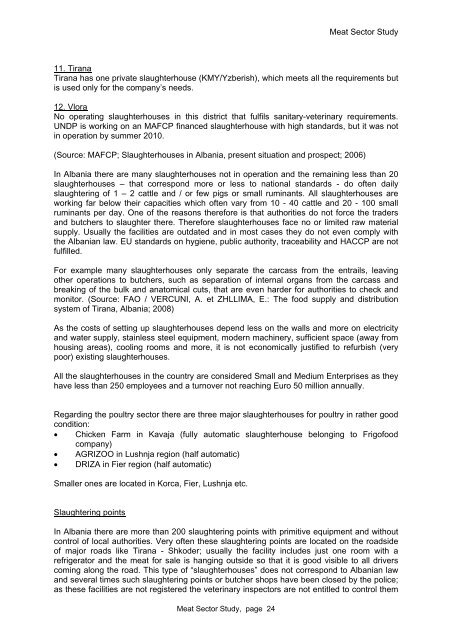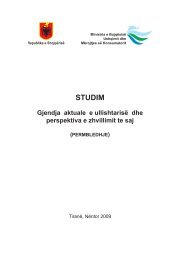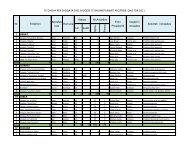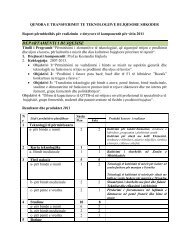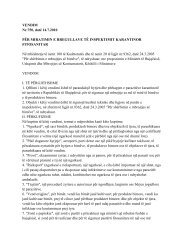MEAT Sector Analyse
MEAT Sector Analyse
MEAT Sector Analyse
- TAGS
- sector
- analyse
- mbumk.gov.al
You also want an ePaper? Increase the reach of your titles
YUMPU automatically turns print PDFs into web optimized ePapers that Google loves.
Meat <strong>Sector</strong> Study<br />
11. Tirana<br />
Tirana has one private slaughterhouse (KMY/Yzberish), which meets all the requirements but<br />
is used only for the company’s needs.<br />
12. Vlora<br />
No operating slaughterhouses in this district that fulfils sanitary-veterinary requirements.<br />
UNDP is working on an MAFCP financed slaughterhouse with high standards, but it was not<br />
in operation by summer 2010.<br />
(Source: MAFCP; Slaughterhouses in Albania, present situation and prospect; 2006)<br />
In Albania there are many slaughterhouses not in operation and the remaining less than 20<br />
slaughterhouses – that correspond more or less to national standards - do often daily<br />
slaughtering of 1 – 2 cattle and / or few pigs or small ruminants. All slaughterhouses are<br />
working far below their capacities which often vary from 10 - 40 cattle and 20 - 100 small<br />
ruminants per day. One of the reasons therefore is that authorities do not force the traders<br />
and butchers to slaughter there. Therefore slaughterhouses face no or limited raw material<br />
supply. Usually the facilities are outdated and in most cases they do not even comply with<br />
the Albanian law. EU standards on hygiene, public authority, traceability and HACCP are not<br />
fulfilled.<br />
For example many slaughterhouses only separate the carcass from the entrails, leaving<br />
other operations to butchers, such as separation of internal organs from the carcass and<br />
breaking of the bulk and anatomical cuts, that are even harder for authorities to check and<br />
monitor. (Source: FAO / VERCUNI, A. et ZHLLIMA, E.: The food supply and distribution<br />
system of Tirana, Albania; 2008)<br />
As the costs of setting up slaughterhouses depend less on the walls and more on electricity<br />
and water supply, stainless steel equipment, modern machinery, sufficient space (away from<br />
housing areas), cooling rooms and more, it is not economically justified to refurbish (very<br />
poor) existing slaughterhouses.<br />
All the slaughterhouses in the country are considered Small and Medium Enterprises as they<br />
have less than 250 employees and a turnover not reaching Euro 50 million annually.<br />
Regarding the poultry sector there are three major slaughterhouses for poultry in rather good<br />
condition:<br />
• Chicken Farm in Kavaja (fully automatic slaughterhouse belonging to Frigofood<br />
company)<br />
• AGRIZOO in Lushnja region (half automatic)<br />
• DRIZA in Fier region (half automatic)<br />
Smaller ones are located in Korca, Fier, Lushnja etc.<br />
Slaughtering points<br />
In Albania there are more than 200 slaughtering points with primitive equipment and without<br />
control of local authorities. Very often these slaughtering points are located on the roadside<br />
of major roads like Tirana - Shkoder; usually the facility includes just one room with a<br />
refrigerator and the meat for sale is hanging outside so that it is good visible to all drivers<br />
coming along the road. This type of “slaughterhouses” does not correspond to Albanian law<br />
and several times such slaughtering points or butcher shops have been closed by the police;<br />
as these facilities are not registered the veterinary inspectors are not entitled to control them<br />
Meat <strong>Sector</strong> Study, page 24


